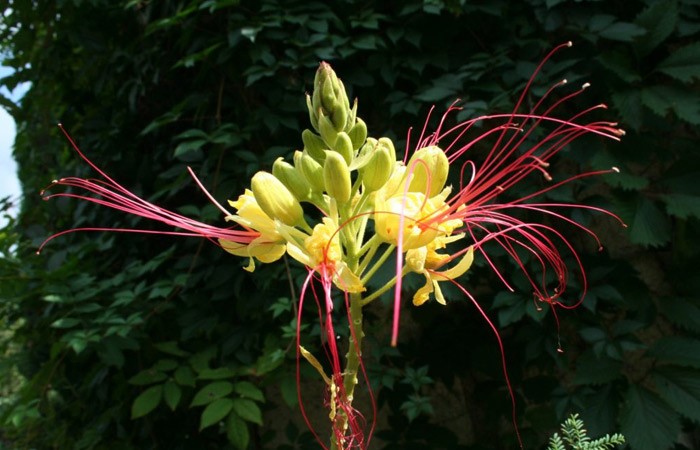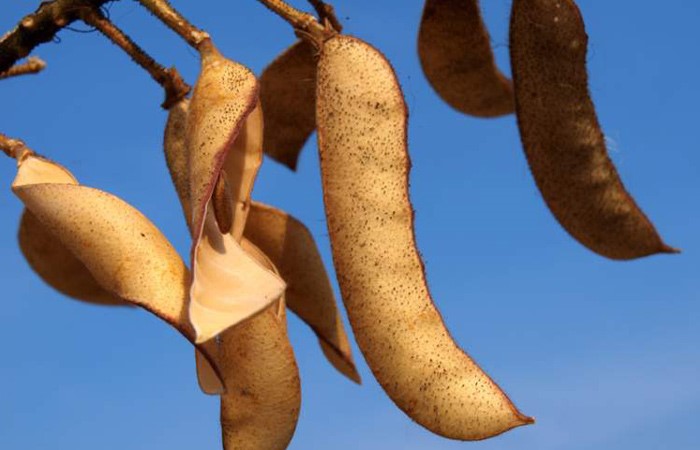Yellow Bird of Paradise

Yellow bird of paradise (Erythrostemon Gilliesii) is an upright, fast growing small tree or shrub from the legume family. Despite its common name, this plant is not related to the bird of paradise genus Strelitzia.
Native to Argentina and Uruguay, yellow bird of paradise is perfect in groups as a fence or screen, or for using as an informal plant. Below, you will find more information about yellow bird of paradise and its care.
Yellow Bird Of Paradise Tree Description
Yellow bird of paradise plant can grow up to 10 feet tall by 8 feet wide. In the summer, it produces clusters of large, bright yellow flowers with long red stamens adorning it.
The fruits are green pods in terminal clusters that turn brown and heavy in summer, weighing down the branches. When yellow bird of paradise pods are fully mature, they split and hurl the seeds.
Yellow bird of paradise has light green featherlike leaves, graying with age. They are 10 to 15 cm long with 3 to 10 pairs of pinnae, each having 6 to 10 pairs of leaflets approximately 5 to 6 mm long by 2 to 4 mm broad. Yellow bird of paradise is long-lived, durable, and tolerant of cold, heat and drought.
It thrives best in full sun exposures, and pruning it encourages dense growth. Note that erythrostemon gilliesii is attractive to bees, butterflies and hummingbirds.
The plant is evergreen in warm climates, and deciduous in cooler seasons. Natural growth habit of this small tree is irregular, open, and almost invasive, but easy to control.
Although this striking ornamental plant is native to South America, it is naturalized in Texas, and is quite common in other southwestern states. In these areas, this plant is also known as bird of paradise bush, desert bird of paradise, and barba de chivo.
It is interesting to know that the indigenous people in Amazon Rainforest use yellow bird of paradise plant (and other similar plants) as a treatment for fever, sores, and cough.
Nevertheless, all parts of the yellow bird of paradise shrub like it ripe seeds are poisonous and should not be ingested, as they provoke other abdominal symptoms.
Yellow Bird of Paradise plant vs. Mexican Bird of Paradise plant

Yellow Bird of Paradise Plant Care
It is best to plant this shrub in partial sun or full sun locations; for example against a warm and sheltered wall. Yellow bird of paradise tree survives in any well-drained soil including rocky, limy, and native soils. But it will not grow well in heavy clay soils.
Yellow bird of paradise plant is considerably resistant to honey fungus, and have a mutual relationship with a kind of soil bacteria. This bacteria forms bulbs on the roots and makes atmospheric nitrogen. The yellow bird of paradise tree and other nearby plants use this nitrogen is for growing.
Water your yellow bird of paradise tree once a week in the summer, once a month in the low-elevation environments, and rarely on rainfall in intermediate elevation environments. You can also prune it in spring to remove dead or damaged stems.
Remember not to prune it severely, as this plant is slower to recover. And since the stem woods of yellow bird of paradise tree are very brittle, you can easily prune with bare hands.

How to Propagate Yellow Bird Of Paradise
People often cultivate this beautiful for its ornamental and exotic flowers. The propagation method for yellow bird of paradise plant is using the seeds and in the following we will tell you how:
Preparing the Seeds
If you already have an erythrostemon gilliesii plant, when it is done blooming in autumn, find 3 to 6 inches pods on its branches. As soon as these pods are tan and brittle, they will twist and crack to cast the yellow bird of paradise seeds away. So we recommend gathering the seeds right before this process.
After cracking open the pods, you need to lay out the seeds on paper towels. This is to make sure that they are completely dry before keeping them in a glass jar with lid in refrigerator. Don not forget to label them as ‘poisonous’ to avoid any problems.
In the early spring, remove the yellow bird of paradise seeds from the refrigerator and scratch them so they can soak up the water. Rub their edges with a file until you see white spots through the shell. You can also nick the seeds. To do so, use pointy-nose pliers to hold the seeds.
Then, chip a small piece of their rounded edge out with knife. Whether you scratch or nick the yellow bird of paradise seeds, do it on the side opposite of where the seed was attached to its stalk inside the pod.
Then, place the seeds into a container of warm water for a day. Later, discard the seeds that did not sink to the bottom. These seeds probably are not viable. The seed should swell as well. If some of them has not, scratch or nick them deeper until they do.
Planting the Seeds
For sowing the seeds, fill a pot with drainage to about 1 inch lower of its top. We recommend a damp combination of 1 part seed-sowing mix and 1 part sand or perlite. Place the seeds with 2 inches of space between them in the pot. Cover them with 1/3 of the soil, and top the container with plastic wrap. For four weeks, until the seeds germinate, keep the soil damp and make sure its temperature is about 77 °F.
After sprouting, remove the plastic wrap and place the pot on a sunny windowsill and keep the soil lightly moist. When the seedlings are large enough to handle, transplant them into individual pots with drainage and cactus potting soil for at least their first winter. After the last spring frost, you need to adapt the seedlings to outdoor conditions before planting them in the ground first. So, place the pots in the shade and gradually move them in a sunnier position.
For planting them in the ground, find a spot with well-drained soil in full or partial sun. Plant them with at 6 feet of space from other plants.
- In this post:
- Yellow Bird Of Paradise Tree Description
- Yellow Bird of Paradise Plant Care
- How to Propagate Yellow Bird Of Paradise



